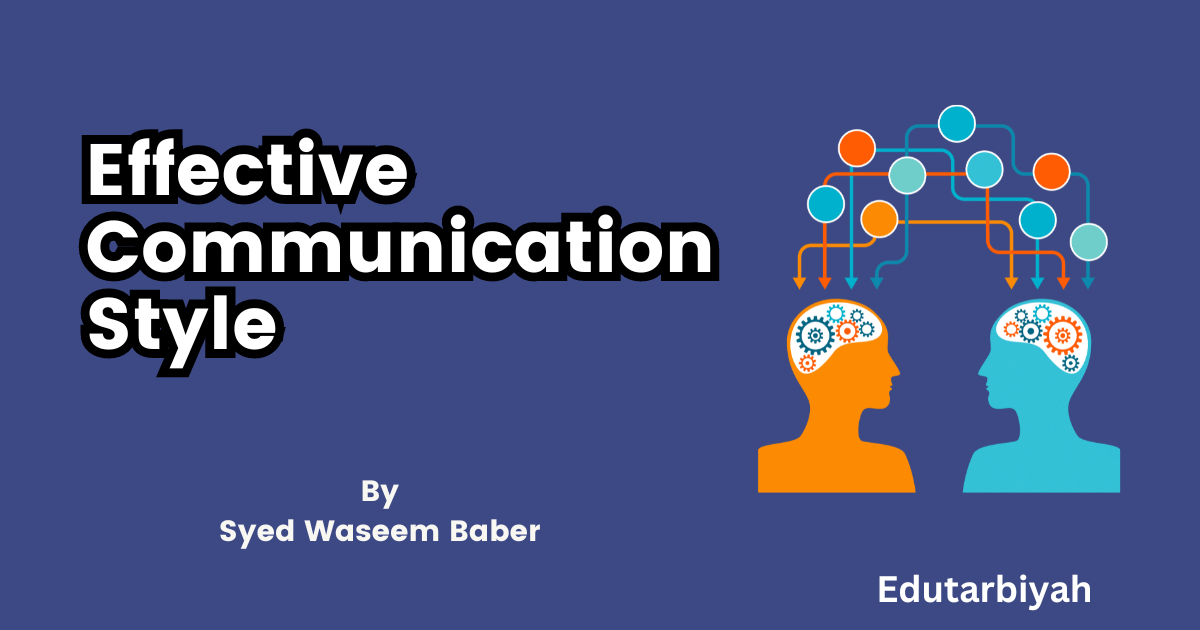Effective Communication Style

Can you name the domain in your life or any step where you do not need communication? You are already aware of the importance of communication skills. And this is not what you have come looking for here. Many of us have grown up understanding what communication is and why it is important. The prime question is how to communicate effectively i.e. get the desired response.
Communication is the process of exchanging information, thoughts, ideas, or feelings between individuals or groups using verbal, non-verbal, or written methods. Effective communication skills involve not only the transmission of information but also the reception and interpretation of that information by the intended recipients. It encompasses various forms, including spoken or written language, body language, facial expressions, gestures, and other non-verbal cues.
Effective communication skills rely on clarity, conciseness, and the ability to adapt the message to the needs and context of the audience. It is a dynamic process that can occur in various settings, from casual conversations to formal presentations, and it is essential for building relationships, fostering collaboration, and achieving common goals. It means that in this process of exchanging, the way (how) we interact determines whether we have a clear understanding, connection and cooperation.
Communication style is defined as the way in which individuals interact with one another and the messages they send, intentionally or not, through their behaviors. It encompasses the combination of verbal and non-verbal elements, including language choice, tone, body language, and other cues that shape the overall communication experience.
4 Types of communication styles for effective communication strategy are:
- Passive
- Aggressive
- Passive aggressive
- Assertive
Let’s discuss each communication style in turn:
-
Passive Style of Communication
Passive communication is a communication style where individuals tend to avoid expressing their thoughts, feelings, or needs openly. Instead of asserting themselves, passive communicators often prioritize avoiding conflict, seeking approval, or maintaining harmony in a situation. Here are some characteristics and behaviors associated with passive communication:
Avoidance of Conflict:
Passive communicators often go to great lengths to avoid confrontation or disagreement.
They may withhold their opinions or needs to prevent potential conflicts.
Reluctance to Express Opinions:
Individuals with a passive communication style may hesitate to express their own thoughts or opinions.
They may fear disapproval or rejection, leading them to keep their feelings to themselves.
Difficulty Saying No:
Passive communicators may find it challenging to say “no” or set boundaries.
They might agree to requests or tasks even when it inconveniences them.
Limited Assertiveness:
Passive communication lacks assertiveness, as individuals may struggle to advocate for themselves.
They may not communicate their needs clearly, making it challenging for others to understand their preferences.
Low Self-Esteem:
Passive communicators may have lower self-esteem, feeling unsure about the validity of their opinions or worthiness of their needs.
They may seek validation from others rather than internally affirming their own value.
Indirect Communication:
Passive communicators often use indirect language or non-verbal cues to express their feelings or needs.
They may expect others to pick up on subtle hints rather than stating their desires explicitly.
Fear of Rejection:
Fear of rejection or disapproval is common among passive communicators.
This fear may prevent them from expressing themselves authentically, as they prioritize avoiding negative reactions.
Difficulty Initiating Conversations:
Passive individuals may struggle to initiate conversations, particularly those involving personal feelings or desires.
They may wait for others to take the lead in communication.
It’s important to note that a passive communication style can sometimes lead to unmet needs, misunderstandings, and frustration. Encouraging individuals to develop more assertive communication skills can empower them to express themselves more effectively and foster healthier relationships.
-
Aggressive Style of Communication
Aggressive communication is a style characterized by forceful, dominating, and often confrontational behavior. Individuals using this style tend to prioritize their own needs and desires over the needs and feelings of others. Aggressive communication can be damaging to relationships and may lead to conflicts. Here are some characteristics and behaviors associated with aggressive communication:
Expressiveness:
Aggressive communicators are expressive and forceful in their communication.
They may use strong language, a loud tone, and intense gestures to convey their messages.
Dominance:
Aggressive individuals seek to dominate conversations and interactions.
They may interrupt others, disregard opposing viewpoints, and insist on their own opinions.
Blame and Criticism:
Aggressive communicators may blame others and criticize them openly.
They often focus on pointing out faults rather than finding solutions.
Lack of Empathy:
Aggressive communicators may show little empathy for the feelings or perspectives of others.
They may dismiss or downplay the emotions of those they are communicating with.
Hostility:
Hostile and confrontational language is common in aggressive communication.
Verbal attacks, insults, or sarcasm may be used to assert dominance.
Impatience:
Aggressive individuals may display impatience and intolerance for differing opinions or perspectives.
They may demand quick compliance and immediate agreement.
Intimidation:
Intimidation tactics, such as raised voices or imposing body language, may be employed to control a situation.
Aggressive communicators may use physical presence to assert dominance.
Win-Lose Mentality:
Aggressive communication often adopts a win-lose mentality, where the goal is to dominate and prevail over others.
Collaboration or compromise may be disregarded in favor of personal victory.
It’s important to recognize that aggressive communication can lead to strained relationships, create a hostile environment, and hinder effective collaboration. Developing more assertive and empathetic communication skills can help individuals express themselves without resorting to aggressive behavior, fostering healthier interactions and resolving conflicts constructively.
-
Passive-aggressive Style of communication
Passive-aggressive communication is a style characterized by indirect expressions of dissatisfaction, resentment, or opposition. Individuals using this style may avoid open confrontation but express their negative feelings through subtle behaviors, sarcasm, or disguised actions. Passive-aggressive communication can lead to misunderstandings and tension in relationships. Here are some characteristics and behaviors associated with passive-aggressive communication:
Indirect Expressions:
Passive-aggressive communicators often express dissatisfaction or disagreement indirectly.
They may use sarcasm, subtle jabs, or veiled comments instead of openly addressing issues.
Avoidance of Conflict:
There is a tendency to avoid direct confrontation or disagreement.
Passive-aggressive individuals may resist addressing issues openly, choosing instead to express their discontent through covert means.
Procrastination:
Procrastination or intentional delays in tasks or responsibilities may be a passive-aggressive response.
By not completing tasks promptly, individuals express their dissatisfaction without directly addressing it.
Sullen Attitude:
Passive-aggressive communicators may display a sullen or resentful attitude without explicitly stating their concerns.
Non-verbal cues such as sighs, eye rolls, or a disapproving demeanor can convey hidden discontent.
Backhanded Compliments:
Passive-aggressive individuals may offer compliments that carry an underlying negative tone.
These compliments may seem positive at first glance but contain subtle criticism or sarcasm.
Silent Treatment:
Withholding communication or giving the silent treatment is a common passive-aggressive behavior.
Instead of openly expressing displeasure, individuals may choose silence as a form of protest.
Sabotage:
Passive-aggressive communicators may engage in subtle sabotage to express their dissatisfaction.
This could involve undermining the efforts of others without direct confrontation.
Feigned Agreement:
Passive-aggressive individuals may agree outwardly but fail to follow through on commitments or promises.
This creates a situation where they can express dissatisfaction later, claiming they never agreed wholeheartedly.
Recognizing passive-aggressive communication is important for addressing underlying issues and fostering healthier interactions. Encouraging open and direct communication can help individuals express their concerns without resorting to indirect or hidden expressions of discontent.
-
Assertive Style of Communication
Assertive communication is a style that involves expressing one’s thoughts, feelings, and needs clearly and confidently while respecting the thoughts and feelings of others. It strikes a balance between being too passive and too aggressive, promoting open and honest interactions. Here are some characteristics and behaviors associated with assertive communication:
Clear Expression:
Assertive communicators express their thoughts and feelings in a clear and straightforward manner.
They use “I” statements to convey their perspective without blaming or accusing others.
Confidence:
Assertive individuals have confidence in their own opinions and are comfortable expressing themselves.
They maintain eye contact and use a steady, composed tone of voice.
Respect for Others:
Assertive communicators acknowledge and respect the opinions and feelings of others.
They listen actively, giving others the opportunity to express themselves.
Setting Boundaries:
Assertive individuals are capable of setting and maintaining personal boundaries.
They communicate their limits and expectations clearly, helping to establish healthy relationships.
Problem-Solving:
Assertive communication involves a focus on finding solutions rather than dwelling on problems.
Assertive individuals engage in constructive conversations to address issues and conflicts.
Directness:
Assertive communicators are direct in their communication, avoiding ambiguity or vague expressions.
They state their needs and expectations openly, contributing to effective understanding.
Emotional Regulation:
Assertive individuals manage their emotions effectively, expressing themselves without undue aggression or suppression.
They can address conflicts calmly and rationally.
Self-Advocacy:
Assertive communication includes advocating for one’s needs and interests without infringing on the rights of others.
It empowers individuals to stand up for themselves in a respectful manner.
Adopting an assertive communication style can lead to positive interpersonal relationships, increased self-esteem, and effective collaboration. It encourages open dialogue, fostering an environment where individuals feel heard and valued.
Conclusion
It’s important to note that individuals may exhibit a combination of these communication styles and a communication style is effective depending on the context, relationships, and the nature of the communication. Effective communication skills often involve recognizing and adapting to various communication styles to promote understanding and collaboration.
